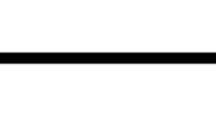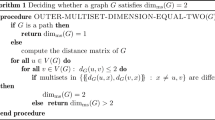Abstract
A linear ordering of the vertices of a graph G separates two edges of G if both the endpoints of one precede both the endpoints of the other in the order. We call two edges \(\{a,b\}\) and \(\{c,d\}\) of G strongly independent if the set of endpoints \(\{a,b,c,d\}\) induces a \(2K_2\) in G. The induced separation dimension of a graph G is the smallest cardinality of a family \(\mathcal {L}\) of linear orders of V(G) such that every pair of strongly independent edges in G are separated in at least one of the linear orders in \(\mathcal {L}\). For each \(k \in \mathbb {N}\), the family of graphs with induced separation dimension at most k is denoted by \({\text {ISD}}(k)\). In this article, we initiate a study of this new dimensional parameter. The class \({\text {ISD}}(1)\) or, equivalently, the family of graphs which can be embedded on a line so that every pair of strongly independent edges are disjoint line segments, is already an interesting case. On the positive side, we give characterizations for chordal graphs in \({\text {ISD}}(1)\) which immediately lead to a polynomial time algorithm which determines the induced separation dimension of chordal graphs. On the negative side, we show that the recognition problem for \({\text {ISD}}(1)\) is NP-complete for general graphs. Nevertheless, we show that the maximum induced matching problem can be solved efficiently in \({\text {ISD}}(1)\). We then briefly study \({\text {ISD}}(2)\) and show that it contains many important graph classes like outerplanar graphs, chordal graphs, circular arc graphs and polygon-circle graphs. Finally, we describe two techniques to construct graphs with large induced separation dimension. The first one is used to show that the maximum induced separation dimension of a graph on n vertices is \(\Theta (\lg n)\) and the second one is used to construct AT-free graphs with arbitrarily large induced separation dimension. The second construction is also used to show that, for every \(k \ge 2\), the recognition problem for \({\text {ISD}}(k)\) is NP-complete even on AT-free graphs.

Similar content being viewed by others
References
Alon, N., Basavaraju, M., Chandran, L.S., Mathew, R., Rajendraprasad, D.: Separation dimension of bounded degree graphs. SIAM J. Discrete Math. 29(1), 59–64 (2015)
Basavaraju, M., Chandran, L.S., Golumbic, M.C., Mathew, R., Rajendraprasad, D.: Boxicity and separation dimension. In: Graph-Theoretic Concepts in Computer Science : Proceedings of the 40th International Workshop on Graph-Theoretic Concepts in Computer Science, WG 2014. LNCS, vol. 8747, pp. 81–92. Springer International Publishing, (2014)
Basavaraju, M., Chandran, L.S., Golumbic, M.C., Mathew, R., Rajendraprasad, D.: Separation dimension of graphs and hypergraphs. Algorithmica 75, 187–204 (2015)
Brandstädt, A., Le, V.B., Spinrad, J.P.: Graph Classes: A Survey. SIAM, Philadelphia (1999)
Broersma, H., Patel, V., Pyatkin, A.: On toughness and Hamiltonicity of \(2K_2\)-free graphs. J. Graph Theory 75(3), 244–255 (2014)
Cameron, K.: Induced matchings. Discrete Appl. Math. 24(1), 97–102 (1989)
Cameron, K.: Induced matchings in intersection graphs. Discrete Math. 278(1), 1–9 (2004)
Cameron, K., Sritharan, R., Tang, Y.: Finding a maximum induced matching in weakly chordal graphs. Discrete Math. 266(1), 133–142 (2003)
Chang, J.-M.: Induced matchings in asteroidal triple-free graphs. Discrete Appl. Math. 132(1), 67–78 (2003)
Chung, F.R.K., Gyárfás, A., Tuza, Z., Trotter, W.T.: The maximum number of edges in \(2K_2\)-free graphs of bounded degree. Discrete Math. 81(2), 129–135 (1990)
Chvátal, V., Hammer, P.L.: Aggregation of inequalities in integer programming. Ann. Discrete Math. 1, 145–162 (1977)
Corneil, D.G., Stacho, J.: Vertex ordering characterizations of graphs of bounded asteroidal number. J. Graph Theory 78(1), 61–79 (2015)
Eaton, N., Faubert, G.: Caterpillar tolerance representations. Bull. Inst. Comb. Appl. 64, 109–117 (2012)
Fishburn, P.C., Trotter, W.T.: Dimensions of hypergraphs. J. Comb. Theory Ser. B 56(2), 278–295 (1992)
Gavril, F.: Maximum weight independent sets and cliques in intersection graphs of filaments. Inf. Process. Lett. 73(5), 181–188 (2000)
Golumbic, M.C.: Algorithmic Graph Theory and Perfect Graphs. Elsevier, Amsterdam (2004)
Golumbic, M.C., Lewenstein, M.: New results on induced matchings. Discrete Appl. Math. 101(1), 157–165 (2000)
Golumbic, M.C., Trenk, A.N.: Tolerance Graphs. Cambridge University Press, Cambridge (2004)
Habib, M., Paul, C., Telle, J.A.: A linear-time algorithm for recognition of catval graphs. In: Eurocomb 2003: European Conference on Combinatorics, Graphs Theory and Applications (2003)
Lovász, L: Coverings and colorings of hypergraphs. In: Proceedings of 4th Southeastern Conference on Combinatorics, Graph Theory, and Computing, pp. 3–12. Utilitas Mathematica Publishing, Winnipeg (1973)
Lozin, V.V., Kaminski, M.: Coloring edges and vertices of graphs without short or long cycles. Contrib. Discrete Math. 2(1), 61–66 (2007)
Lozin, V.V., Mosca, R.: Independent sets in extensions of \(2K_2\)-free graphs. Discrete Appl. Math. 146(1), 74–80 (2005)
Mycielski, J.: Sur le coloriage des graphes. Colloq. Math. 3, 161–162 (1955)
Roberts, F.S.: On the boxicity and cubicity of a graph. In: Tutte, W.T. (ed.) Recent Progresses in Combinatorics, pp. 301–310. Academic Press, New York (1969)
Telle, J.A.: Tree-decompositions of small pathwidth. Discrete Appl. Math. 145(2), 210–218 (2005)
Author information
Authors and Affiliations
Corresponding author
Rights and permissions
About this article
Cite this article
Ziedan, E., Rajendraprasad, D., Mathew, R. et al. The Induced Separation Dimension of a Graph. Algorithmica 80, 2834–2848 (2018). https://doi.org/10.1007/s00453-017-0353-x
Received:
Accepted:
Published:
Issue Date:
DOI: https://doi.org/10.1007/s00453-017-0353-x




